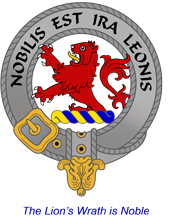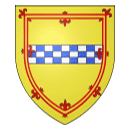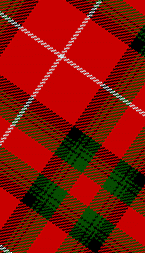
|
|
|
|
|
|
The Stewarts, were of Norman origins, migrating from Brittany through England to Scotland by the 12th century. They took the name Stewart as a surname, which was derived from High "Steward," the official name for the person in charge of the household and treasury of the King. Which was the official, and hereditary, office they held for several generations of Scottish Kings. The chiefs of this clan would eventually become the Kings and Queen of Scotland as well as the Kings and Queens of England. In the 16th century this branch of the Stewart family adopted the French spelling of the name - Stuart - there being no "w" in the French alphabet. The French spelling was first adopted by the grandfather of James VI, the 4th Earl of Lennox, who took French nationality in 1537 and changed his name from Matthew Stewart to Matthew Stuart. When the young Mary Queen of Scots returned to Scotland, she maintained the French spelling as did her descendants. It became fashionable to spell the name like the Queen and those Stewarts on the Isle of Bute as well as the Royal House of Stuart (Kings and Queens of England) adopted the French spelling of the name. Although by the early 12th century the island of Bute was considered part of the domain of Walter, the first High Steward, it was actually taken by force and held by Norsemen as part of the Hebrides, until seized by the Scots after the battle of Largs in 1263.
Several Jameson's can be found in important positions of power on Bute into the mid 1700's. This would have made them influential within this clan. From 1436 to 1458 Niel Jamieson (Nigellus Jacobi) was the Chamberlain (camerarius) of Bute, and was responsible for the rents paid by tenants in the isle to the Crown. In 1458 when the king was in residence in Rothesay, Neil made such a poor mouth about the bad weather for the past twenty-two years and the loss of his fees from Arran, which had been scoured by raiders in 1444, that the compassionate monarch allowed him an extra payment of 8 chalders, for his vexations in gathering and dispatching the royal rents, or marts, to the courts. In 1506, Robert Jamesoun is enumerated among the so-called "Barons of Bute" who received charters from King James IV. In 1534, apparently the same individual, Robert Neilsoun, is confirmed by James V in the Crownership of the island and sheriffdom of Bute, which according to the deed of the grant, been held hereditarily by the family above two hundred years. In 1642, "Robert Jamieson, Crowner," the last of his family in the office, was an elder in the Church of Rothesay. After 1672 the Crowner's duties were transfered to other officers, and in 1748 the heritable jurisdiction was abolished by Act of Parliament.[3] Besides holding important heridarty office for over three centuries, Jamesons on Bute had considerable landed property, which included Kilmorie, the Jamiesons' ancient castle in Rothesay parish, Buteshire, on the west coast of Bute island, opposite Inchmarnock; sometimes known as Crowner’s Castle, a sixteenth-century fortified keep. Its towers and other buildings are now in utter ruin,[4] which lapsed to the Bute family in 1780. The history of this clan is rich in its descriptions of many of their chiefs, their life and their battles, all of which is documented well elsewhere. As this is not intended to be a history of the clan the interested reader is urged to separately seek out this documentation. [1] dilecto fratri nostro, Joanni Senescallo de Bute,’ 11th November 1400 - www.electricscotland.com [2] Andrew McLean MA(Hons), PGCE(Sec), Dip.Arch.Ad. Mount Stuart Archivist [3] The Isle of Bute in Olden Time - James King Hewison - W. Blackwood & Sons - pp 161-163 [4] Ordance Gazetter of Scottland - Vol 4 - pp 381 |
- please contact us regarding any broken links - or to suggest or submit further content.
 The Scottish Clan Stuart of Bute is a main branch of the Stewart family and takes it's name owing to their occupation of the Isle of Bute, at the mouth of the river Clyde, near what was county Argyle (Argyllshire) in western Scotland. Jamison/Jameson (at one time MacKechnie and/or MacHamish) is one of several septs of this clan.
The Scottish Clan Stuart of Bute is a main branch of the Stewart family and takes it's name owing to their occupation of the Isle of Bute, at the mouth of the river Clyde, near what was county Argyle (Argyllshire) in western Scotland. Jamison/Jameson (at one time MacKechnie and/or MacHamish) is one of several septs of this clan.
 The Scots regained the island which remained a Stewart possession thereafter, except for a brief English occupation. However, it was only after 1385 that this family branch became properly established there, when Sir John Stewart, an illegitimate son of King Robert II, known as the Black Stewart, probably because of his dark complexion and to distinguish him from his brother John of Dundonald, another illegitimate son of King Robert II, known as the 'Red Stewart,' was granted the lands of Bute, Arran and Cumbrae and appointed hereditary Sheriff of Bute and Arran. His descendants still hold the Marquessate of Bute. The island included the castle at Rothesay, with its wet moat, a favorite of King Robert II and the home of the Stuart's of Bute before they moved to Mount Stuart. The grant of lands on Bute along with the hereditary office of Sherif of Bute was confirmed in 1400 by a Charter from Robert III.
The Scots regained the island which remained a Stewart possession thereafter, except for a brief English occupation. However, it was only after 1385 that this family branch became properly established there, when Sir John Stewart, an illegitimate son of King Robert II, known as the Black Stewart, probably because of his dark complexion and to distinguish him from his brother John of Dundonald, another illegitimate son of King Robert II, known as the 'Red Stewart,' was granted the lands of Bute, Arran and Cumbrae and appointed hereditary Sheriff of Bute and Arran. His descendants still hold the Marquessate of Bute. The island included the castle at Rothesay, with its wet moat, a favorite of King Robert II and the home of the Stuart's of Bute before they moved to Mount Stuart. The grant of lands on Bute along with the hereditary office of Sherif of Bute was confirmed in 1400 by a Charter from Robert III. Additional offices and titles followed for the Black Stewart's descendants; Ninian Stewart was made Hereditary Captain and Keeper of Rothesay Castle in 1498; Sir James Stewart became a Baronet of Scotland and Nova Scotia in 1627; another James (died 1710) was created 1st Earl of Bute in 1703; the 4th Earl, John Stewart (died 1814), was made 1st Marquess of Bute in 1796 and his grandson, who inherited the Marquessate from him, also became, through marriage, Earl of Dumfries.
Additional offices and titles followed for the Black Stewart's descendants; Ninian Stewart was made Hereditary Captain and Keeper of Rothesay Castle in 1498; Sir James Stewart became a Baronet of Scotland and Nova Scotia in 1627; another James (died 1710) was created 1st Earl of Bute in 1703; the 4th Earl, John Stewart (died 1814), was made 1st Marquess of Bute in 1796 and his grandson, who inherited the Marquessate from him, also became, through marriage, Earl of Dumfries.